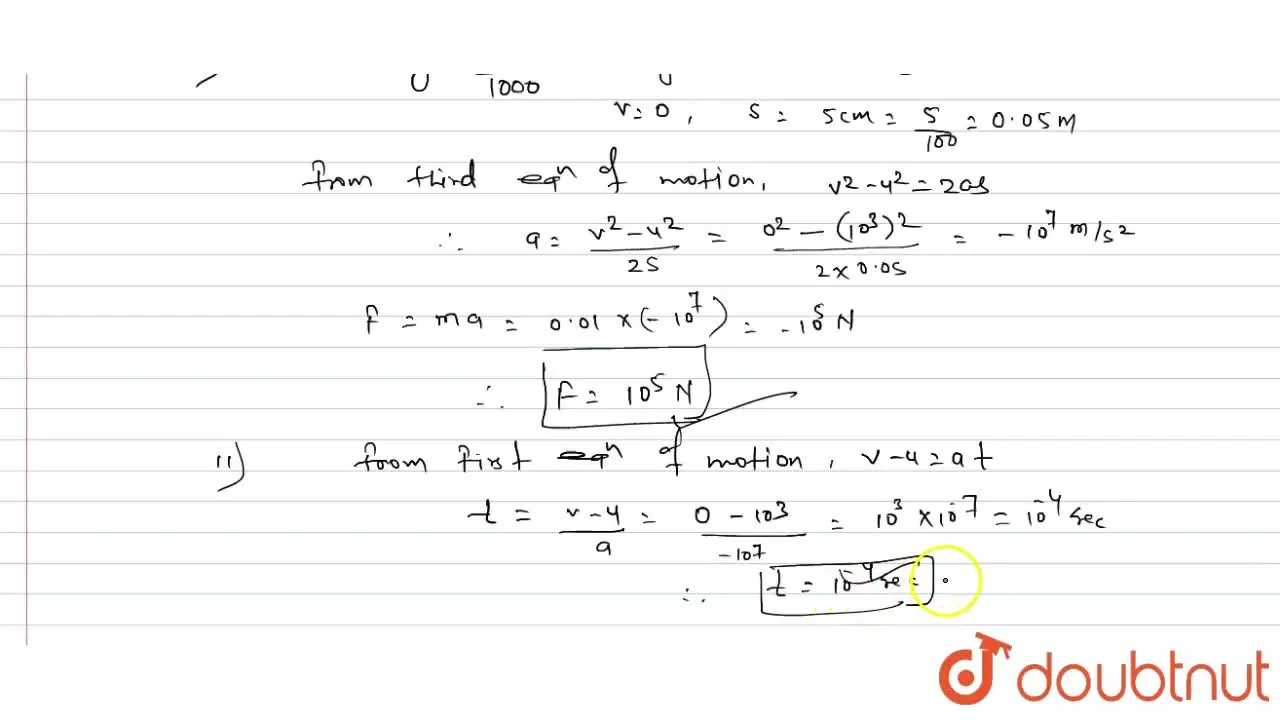Using second law of motion, derive the relation between force and acceleration. A bullet of 10g strikes a sand-bag at a speed of 103ms−1 and gets embedded after travelling 5cm.Calculate
(i) the resistive force exerted by the sand on the bullet (ii) the time taken by the bullet to come to rest.
If a body of mass (m), moving at velocity (v) accelerates uniformity at (a) for time 't'. So that its velocity changes to v, then
Initial momentum p1=μ
and final mementum p2=μ
Change in momentum=p2−p1=mv−μ=m(u−v)
According to the second law of motion, force FαChange in momentumTime
⇒Fαp2−p1t
⇒Fαm(v−u)t
⇒Fαma(where,v−ut=a)
HereF−kma
∴F=ma
Given, m=10g=101000kg=0.01kg.u=103m/s,v=0[∴1kg=1000g]
and , s=5cm=5100m=0.05m[∴1m=100cm]
(i) From the third equation of motionv2=u2+2as
⇒v2−u2=2as
⇒a=v2−u22s=(0)2−(103)22×0.05
a=−106−.1=107m/s
Now, force applied by the bullet. F=ms =0.01×10−7=−105N [negative sign shown against the direction of motion]
The resistive force exerted by the sand on the bullet=105N
(ii) From first equation of motion. v=u+at
⇒at=v−u
Now, time taken by bullet come to rest. t=v−ua
⇒t=0−103−107
⇒t=−103−107=103×10−7
⇒t=10−4s
Hence, force (F) =105N and time=(t)=10−4s
Related Playlists
Similar Questions
A bullet of mass 40g moving with a speed of 90ms−1 enters a heavy wooden block and is stopped after a direction of 60cm. The average resistive force exered by the block on the bullet is
View SolutionA bullet of mass 0.06 kg moving with a speed of 90ms−1 enters a heavy wooden block and it stopped after a distance of 60 cm. What is the average resistive force exerted by the block on the bullet ?
View SolutionA bullet of mass 40 g moving with a speed of 90ms−1 enters a heavy wooden block and is stopped after a distance of 60 cm . The average resistive force exerted by the block on the bullet is :
View SolutionA bullet of mass 0.04 kg moving with a speed of 90ms−1 enters a heavy wooden block and is stooped after a distance of 60 cm . What is the average resistive force exerted by the block on the bullet ?
View SolutionA bullet of mass 0.005 kg moving with a speed of 200 ms−1 enters a heavy wooden block and is stopped after a distance of 50 cm. What is the average force exerted by the block on the bullet?
View SolutionA bullet of mass 50 g moving with an initial velocity 100m s−1 strikes a wooden block and comes to rest after penetrating a distance 2 cm in it. Calculate : Resistive force exerted by the wooden block.
View SolutionA bullet of mass 50 is moving with a velocity of 500 ms−1 . It penetrates 10 cm into a still target and comes to rest Calculate (a) the kinetic energy possessed by the bullel and (b) the average retarding force offered by the target.
View SolutionA hammer of mass 1 kg moving with speed of 6ms−1 strikes a wall and comes to rest in 0.1 s . Calculate (i) the impules of force (ii) the retardation of the hammer , and (iii) the retarding that stops the hammer .
View SolutionA bullet of mass 25 g is fired horizontally into a ballistic pendulum of mas 5.0 kg and gets embedded in it figure. If the centre of the pendulum rises by a distance of 10 cm, find the speed of the bullet.
View SolutionA bullet moving with a speed of 150ms−1 strikes a tree and penetrates 3.5 cm before stopping. What is the magnitude of its retardation in the tree and the time taken for it to shop after striking the tree?
View Solution


